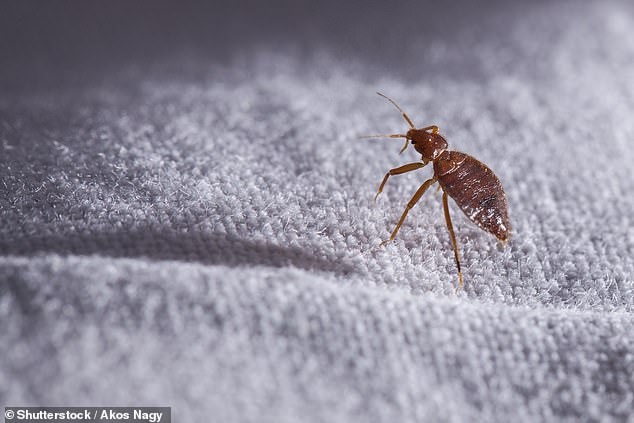Does my home insurance cover bedbugs? I’m facing a £300 bill to get rid of them
I want to know if there is a way for my home insurance to cover the cost of bed bug removal, even though I fear the worst.
I recently returned from a trip to France, and when I read stories about British travelers bringing home bedbugs, I became suspicious, as I was recently bitten at night by what I assumed was a mosquito.
But when I took the covers off the bed and looked closely, I saw that there were bed bugs hiding in the seams of the mattress.
I haven’t contacted my insurer yet but have a feeling they won’t pay this out, leaving me with a bill of £300. Is there a way I can claim these costs please? Via email

Go pro, go bugs: Getting a professional to exterminate bed bugs instead of relying on DIY treatments can cost hundreds of dollars, but gives you a better chance of getting the bugs gone for good
Sam Barker from This is Money answers: Bed bugs made headlines recently as many travelers reported seeing the bugs in Britain, with an outbreak of the bugs in France the likely reason.
Bed bug infestations can be horrible, time consuming and expensive to deal with.
The British Pest Control Association (BPCA) trade body said one female adult bedbug can lay up to 10 eggs a day, and up to 500 over their lifetime, meaning infestations can grow quickly if not spotted and dealt with.
According to rent control agency Rentokil, the pesky blood-sucking pests were once virtually undetected in this country.
But bedbugs are on the rise again thanks to Britain’s love of international travel, with holidaymakers taking the bugs home with them. Rentokil alone treated 65 percent more bedbug infestations in the second quarter of 2023 than the year before.
Now bedbugs have been found everywhere from homes to airlines, the Houses of Parliament and reportedly even on the London Underground.
Unfortunately, you are correct that most home insurance policies will not cover the cost of bed bug control, and yours is no exception.
However, there are special insurance deals that may be able to help with the costs of treating future infestations.

On the Go: Bed bugs are relatively stationary and new infestations normally arise because they hitchhike on the clothing and luggage of unsuspecting people
Standard home insurance policies do not cover the cost of removing pests, whether rats, mice or bed bugs.
The logic of insurers here is that they should not pay out for something that a policyholder could reasonably avoid. In insurance language, this is a ‘moral hazard’, because the presence of the cover would encourage risky behavior.
In the case of bed bugs, if insurers cover the cost of treatment, knowing this makes homeowners less likely to prevent infestations or nip them in the bud early.
That means higher claim costs for insurers for something that could be prevented, higher premiums for all policyholders and a greater chance of causing further bed bug infestations.
For example, the only exception where pest damage is covered by insurance is in the type of situation where a rat gnaws through the pipes in your bathroom and causes a serious water leak.
Pipe damage is not covered, but if one of your belongings is damaged, home contents insurance will likely cover the water damage.
But bedbugs do not cause material damage and are therefore of course excluded from the conditions of home insurance.
You also probably won’t have much luck with your home emergency coverage, which is often sold as a supplement to home insurance.
Many of these deals will cover the cost of removing a sudden infestation, but specifically exclude bed bugs.
Angela Pilley, home insurance expert at financial data company Defaqto, said: ‘Although unwanted and extremely unpleasant, bedbugs do not cause damage to the home, but even if you have other pests or pests that have caused physical damage, they are unlikely to this happens. are covered by your home insurance as most products exclude this.
‘If you have home emergency cover it may provide some cover for pest or vermin removal, but this is often limited to a specific list, such as wasp nests, hornet nests, mice, rats and, less commonly, gray squirrels and cockroaches .’
However, there is a type of insurance that is better suited for bed bug control, namely pest insurance.
Tests carried out by This is Money suggest this currently costs around £18 to £60 per year, with offers also covering the removal of other pests such as rats, mice and hornets.
However, this must be weighed against the likely likelihood that a policyholder will make a claim, as well as the common practice of limiting payouts to £150 to £200.
This is unlikely to cover the full cost of treating a bedbug infestation, which normally starts at £200 to £350 and can run into the thousands.
Unfortunately, it seems like the best course of action is to pay for the treatment yourself and consider purchasing pest insurance if you think a bedbug infestation is likely in the future.
Natalie Bungay, technical manager at trade body BPCA, said: ‘Bedbugs are traveling pests and like to migrate. They cling to items such as luggage, clothing and second-hand furniture and are transported to your home.
‘This also means they can end up on public transport or in public buildings such as cinemas, and unfortunately also how people can take them home from holiday.
‘Bed bugs are notoriously difficult to treat and DIY treatments often result in failure.’
Some links in this article may be affiliate links. If you click on it, we may earn a small commission. That helps us fund This Is Money and keep it free to use. We do not write articles to promote products. We do not allow a commercial relationship to compromise our editorial independence.

